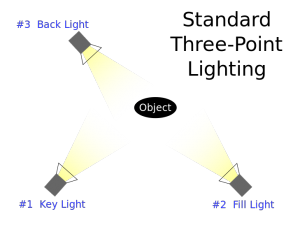Three-point lighting
Three-point lighting is a method usually used in film. To get the desired lighting of the object, the photographer uses three different positioned and separate lights to illuminate the object. At the same time it also balances and controls the shadows on the object created by the direct sunlight.
Key light
Key light, just like what it is called, is the key illuminator of the entire lighting situation. It determines the whole lighting design of the shot. It should be place directly upon the object. In indoor shots, key light is usually a specialized lamp or the flash on camera. In outdoor shots, the key light is the sun. To get the light you want, you should always wait for the sun to get the right position, then start shooting.
Fill light
Fill light is usually shining from the side angle and at the lower position than key light, usually about the level of object’s face. It is softer and about half less brighter than key light. It helps balance the key light and illuminate the shadows on the person’s face. If the key light is harsh and there is not a fill light, this will result in stark contrasts.
A reflector like a piece of white card stock or a white-painted wall can be a fill light sometimes. ‘Reflecting and redirecting the key light’s rays back upon the subject from a different angle can cause a softer, subtler effect than using another lamp’ (Wikipedia).
Back light
Back light illuminate objects from back to create a thin outline and to separate the object from its background.
Reference: Wikipedia, Three-point lighting, available at <wikipedia.org/wiki/Three-point_lighting>, viewed online: 15 October 2015.
